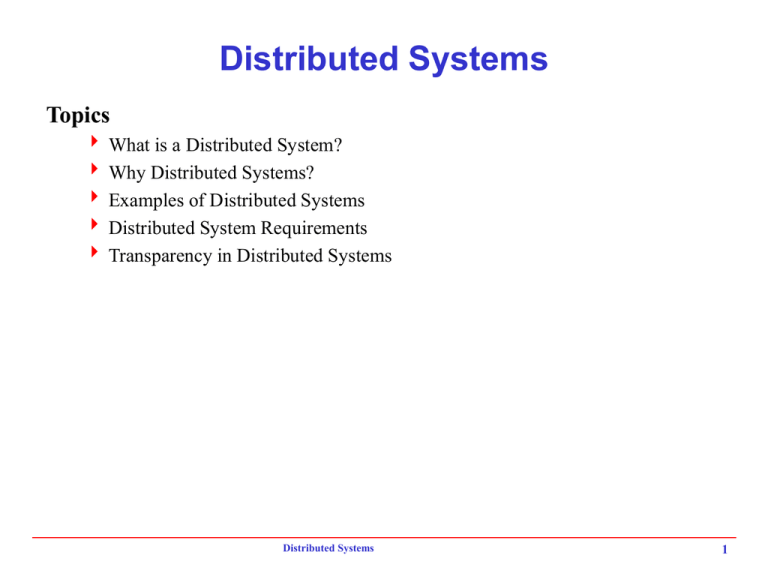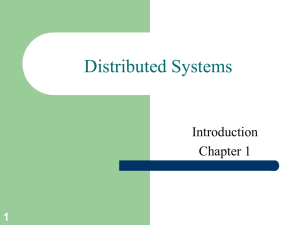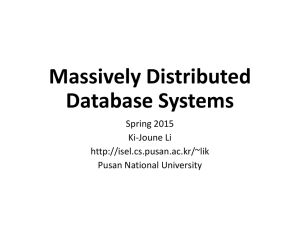Distributed Computing
advertisement

Distributed Systems Topics What is a Distributed System? Why Distributed Systems? Examples of Distributed Systems Distributed System Requirements Transparency in Distributed Systems Distributed Systems 1 Distributed Systems Can think of DS as: breaking down an application into individual computing agents distributed over a network work together on a cooperative task Motivation for DC: Scalability: can solve larger problems without larger computers Openness and heterogeneity: applications and data may be difficult to relocate and reconfigure Fault-tolerance: redundant processing agents for system availability Distributed Systems 2 What Is a Distributed System? Ingredients of a Distributed System Component-1 … Component-n Component-1 … Component-m Network OS Network OS Hardware Hardware Host-1 Host-n Component-1 … Component-n Middleware Network OS Hardware Host-1 Distributed Systems 3 What Is a Distributed System? Component-1 Component-1 … Component-1 Component-n … Component-n Middleware Middleware Network OS Network OS Hardware Hardware Host-1 Host-2 … Network Component-n Component-1 … Component-n Middleware Middleware Network OS Network OS Hardware Hardware Host-n Host-3 Distributed Systems 4 What is a Distributed System Distributed System Definition: A distributed system is a collection of autonomous hosts that are connected through a computer network. Each host executes components and operates a distribution middleware. Middleware enables the components to coordinate their activities. Users perceive the system as a single, integrated computing facility. Distributed Systems 5 Why Distributed Systems? Every application is part of your business model must make them work together! Payables/ Receivables Sales Accounting Manufacturing Inventory Shipping/ Receiving Engineering Distributed Systems 6 Why Distributed Systems? Application Integration and Distributed Processing are the same thing Constructing information-sharing distributed systems from diverse sources: heterogeneous networked physically disparate multi-vendor Distributed Systems 7 Why Distributed System? Application Requirements Functional Non-Functional Non-functional requirements drive distribution of a system Scalability Concurrency Openness Heterogeneity Resource sharing Fault-tolerance … Distributed Systems 8 Centralized vs Distributed Systems Centralized Systems Centralized systems have non-autonomous components Centralized systems are often build using homogeneous technology Multiple users share the resources of a centralized system at all times Centralized systems have a single point of control and of failure Distributed Systems Distributed systems have autonomous components Distributed systems may be built using heterogeneous technology Distributed system components may be used exclusively Distributed systems are executed in concurrent processes Distributed systems have multiple points of failure Distributed Systems 9 Advantages and Disadvantages of Distributed Systems Advantages Shareability Expandability Local autonomy Improved performance Improved reliability and availability Potential cost reductions Disadvantages Network reliance Complexities Security Multiple point of failure Distributed Systems 10 History Review of Distributed Systems Late 70’s and early 80’s: synchronous with distributed processing Mid 80’s: no point of central control Late 80’s: peer structure and inter-connection configuration Later: more fine-grained distribution Software is decomposed into components Components can resides on different computers and be implemented with different languages Distributed Systems 11 Examples of Distributed Systems Video-on-Demand Client components are used to display videos Clients are hosted in the homes of the customers of the service Server components load and transmit videos Multiple servers are needed in order to scale Distributed Systems 12 Examples of Distributed Systems IT Service Architecture of a Swiss Bank Service architecture consists of heterogeneous new and legacy components Hardware platforms range from mainframes to NTs Programming languages including Assembler, Cobol, C, C++, Java, … Different types of middleware can be used to resolve distribution and heterogeneity Authorization Services Customer Information Services Trading Services ATM Services Distributed Systems 13 Transparency in Distributed Systems Distributed System Definition: A distributed system is a collection of autonomous hosts that are connected through a computer network and coordinate with each other in such a way that users perceive the system as a single and integrated computing facility. Dimensions of transparency in DS Access Transparency Location Transparency Migration Transparency Replication Transparency Concurrency Transparency Scalability Transparency Performance Transparency Failure Transparency Distributed Systems 14 Location Transparency Caller Machine 1 local call Machine 2 remote call Implementor Proxy Distributed Systems 15 Summary Distributed systems Centralized systems vs distributed systems The need for distributed systems --- application’s non-functional requirements Transparencies Dependencies among different dimensions of transparencies Distributed Systems 16







